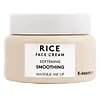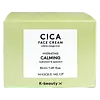What's inside
What's inside
 Key Ingredients
Key Ingredients

 Benefits
Benefits

 Concerns
Concerns

 Ingredients Side-by-side
Ingredients Side-by-side

Water
Skin Conditioning2,3-Butanediol
HumectantCetyl Ethylhexanoate
EmollientMethylpropanediol
SolventHydrogenated Polydecene
Emollient1,2-Hexanediol
Skin ConditioningGlycerin
HumectantPolyglyceryl-3 Methylglucose Distearate
EmulsifyingNiacinamide
SmoothingCetearyl Alcohol
EmollientOryza Sativa Bran Water
MaskingGlyceryl Stearate
EmollientPalmitic Acid
EmollientVinyldimethicone
Stearic Acid
CleansingSodium Polyacryloyldimethyl Taurate
Emulsion StabilisingCarbomer
Emulsion StabilisingTromethamine
BufferingEthylhexylglycerin
Skin ConditioningXanthan Gum
EmulsifyingSodium Phytate
Caprylyl/Capryl Glucoside
CleansingWater, 2,3-Butanediol, Cetyl Ethylhexanoate, Methylpropanediol, Hydrogenated Polydecene, 1,2-Hexanediol, Glycerin, Polyglyceryl-3 Methylglucose Distearate, Niacinamide, Cetearyl Alcohol, Oryza Sativa Bran Water, Glyceryl Stearate, Palmitic Acid, Vinyldimethicone, Stearic Acid, Sodium Polyacryloyldimethyl Taurate, Carbomer, Tromethamine, Ethylhexylglycerin, Xanthan Gum, Sodium Phytate, Caprylyl/Capryl Glucoside
Water
Skin ConditioningCetyl Ethylhexanoate
EmollientGlycerin
Humectant2,3-Butanediol
HumectantCetearyl Alcohol
EmollientGlyceryl Stearate
EmollientVinyldimethicone
Behenyl Alcohol
EmollientPolyglyceryl-2 Stearate
EmulsifyingButyrospermum Parkii Butter
Skin ConditioningStearyl Alcohol
EmollientSodium Polyacryloyldimethyl Taurate
Emulsion StabilisingCaprylyl Glycol
EmollientEthylhexylglycerin
Skin ConditioningAmmonium Acryloyldimethyltaurate/Vp Copolymer
Hydrogenated Polydecene
EmollientParfum
MaskingPanthenol
Skin ConditioningSodium Phytate
Butylene Glycol
HumectantCaprylic/Capric Triglyceride
MaskingCaprylyl/Capryl Glucoside
CleansingCentella Asiatica Extract
CleansingHydrogenated Lecithin
Emulsifying1,2-Hexanediol
Skin ConditioningCeramide NP
Skin ConditioningCitric Acid
BufferingWater, Cetyl Ethylhexanoate, Glycerin, 2,3-Butanediol, Cetearyl Alcohol, Glyceryl Stearate, Vinyldimethicone, Behenyl Alcohol, Polyglyceryl-2 Stearate, Butyrospermum Parkii Butter, Stearyl Alcohol, Sodium Polyacryloyldimethyl Taurate, Caprylyl Glycol, Ethylhexylglycerin, Ammonium Acryloyldimethyltaurate/Vp Copolymer, Hydrogenated Polydecene, Parfum, Panthenol, Sodium Phytate, Butylene Glycol, Caprylic/Capric Triglyceride, Caprylyl/Capryl Glucoside, Centella Asiatica Extract, Hydrogenated Lecithin, 1,2-Hexanediol, Ceramide NP, Citric Acid
Ingredients Explained
These ingredients are found in both products.
Ingredients higher up in an ingredient list are typically present in a larger amount.
1,2-Hexanediol is a synthetic liquid and another multi-functional powerhouse.
It is a:
- Humectant, drawing moisture into the skin
- Emollient, helping to soften skin
- Solvent, dispersing and stabilizing formulas
- Preservative booster, enhancing the antimicrobial activity of other preservatives
2,3-Butanediol is a naturally occurring humectant and solvent. It's created from fermentation and can be found in foods like cocoa butter and sweet corn.
This ingredient attracts and holds onto moisture to boost hydration in skin. According to a manufacturer, this ingredient improves the spreadability of ingredients like vitamin C.
Caprylyl/Capryl Glucoside is an alkyl glucoside. This just means it is creating by reacting alcohol and sugar. It is a cleansing and foaming ingredient.
Caprylyl/Capryl Glucoside helps remove the dirt, oil, and other pollutants from your skin.
Cetearyl alcohol is a mixture of two fatty alcohols: cetyl alcohol and stearyl alcohol. It is mainly used as an emulsifier. Emulsifiers help prevent the separation of oils and products. Due to its composition, it can also be used to thicken a product or help create foam.
Cetearyl alcohol is an emollient. Emollients help soothe and hydrate the skin by trapping moisture.
Studies show Cetearyl alcohol is non-toxic and non-irritating. The FDA allows products labeled "alcohol-free" to have fatty alcohols.
This ingredient is usually derived from plant oils such as palm, vegetable, or coconut oils. There is debate on whether this ingredient will cause acne.
Due to the fatty acid base, this ingredient may not be Malassezia folliculitis safe.
Learn more about Cetearyl AlcoholCetyl Ethylhexanoate is an emollient ester. It comes from cetearyl alcohol and 2-ethylhexanoic acid.
Cetyl Ethylhexanoate is an emollient that adds a velvety feel to skin without being greasy or oily. Emollients help trap moisture into your skin, keeping your skin soft and hydrated.
Ethylhexylglycerin (we can't pronounce this either) is commonly used as a preservative and skin softener. It is derived from glyceryl.
You might see Ethylhexylglycerin often paired with other preservatives such as phenoxyethanol. Ethylhexylglycerin has been found to increase the effectiveness of these other preservatives.
Glycerin is already naturally found in your skin. It helps moisturize and protect your skin.
A study from 2016 found glycerin to be more effective as a humectant than AHAs and hyaluronic acid.
As a humectant, it helps the skin stay hydrated by pulling moisture to your skin. The low molecular weight of glycerin allows it to pull moisture into the deeper layers of your skin.
Hydrated skin improves your skin barrier; Your skin barrier helps protect against irritants and bacteria.
Glycerin has also been found to have antimicrobial and antiviral properties. Due to these properties, glycerin is often used in wound and burn treatments.
In cosmetics, glycerin is usually derived from plants such as soybean or palm. However, it can also be sourced from animals, such as tallow or animal fat.
This ingredient is organic, colorless, odorless, and non-toxic.
Glycerin is the name for this ingredient in American English. British English uses Glycerol/Glycerine.
Learn more about GlycerinGlyceryl Stearate is a mix of glycerin and stearic acid.
It is used to stabilize the mixing of water and oil ingredients. By preventing these ingredients from separating, it can help elongate shelf life. It can also help thicken the product's texture.
As an emollient, it helps soften skin and supports barrier-replenishing ingredients.
In cosmetics, Glyceryl Stearate is often made from vegetable oils or synthetically produced.
This ingredient may not be fungal-acne safe
Fun fact: The human body also creates Glyceryl Stearate naturally.
Learn more about Glyceryl StearateHydrogenated Polydecene is an emollient. It creates a non-occlusive film on the skin that offers extra protection for your skin barrier.
The texture of Hydrogenated Polydecene ranges from light and silky to rich.
Hydrogenated Polydecene is the end compound of controlled hydrogenation of Polydecene.
Learn more about Hydrogenated PolydeceneSodium Phytate is the synthetic salt form of phytic acid. Phytic acid is an antioxidant and can be found in plant seeds.
Sodium Phytate is a chelating agent. Chelating agents help prevent metals from binding to water. This helps stabilize the ingredients and the product.
Sodium Polyacryloyldimethyl Taurate is a polymer and used to help stabilize other ingredients.
Emulsion stabilizers hold ingredients together, helping to create an even texture throughout the product.
Sodium Polyacryloyldimethyl Taurate can also be used to thicken the texture.
Learn more about Sodium Polyacryloyldimethyl TaurateVinyldimethicone is a type of silicone.
Water. It's the most common cosmetic ingredient of all. You'll usually see it at the top of ingredient lists, meaning that it makes up the largest part of the product.
So why is it so popular? Water most often acts as a solvent - this means that it helps dissolve other ingredients into the formulation.
You'll also recognize water as that liquid we all need to stay alive. If you see this, drink a glass of water. Stay hydrated!
Learn more about Water